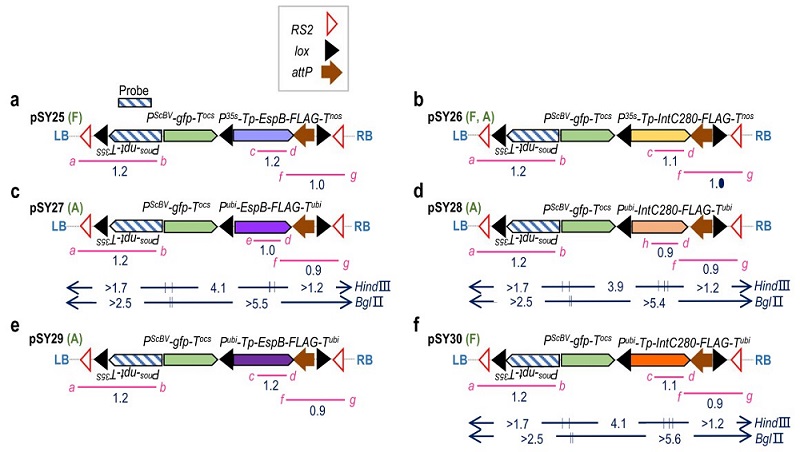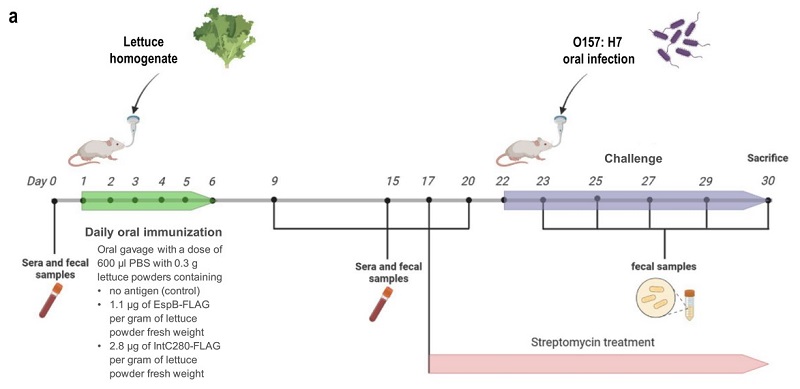

Enterohemorrhagic Escherichia coli (EHEC) O157: H7 is a subset of the Shiga toxin-producing food-borne pathogen that causes diarrhea, hemorrhagic colitis and hemolytic uremic syndrome. The reservoirs of EHEC O157: H7 are ruminants, mainly bovine. Bovine vaccination has been used to prevent disease outbreaks, and the current method relies on vaccines subcutaneously injected three times per year. However, the vaccination procedures are too complicated and too costly to make the vaccines marketable. Since EHEC O157: H7 colonizes mucosal surfaces, the oral vaccination that is convenient and low-cost, and produces an IgA response could be more acceptable to the market.
The researchers from the former group led by Dr. David W. Ow in South China Botanical Garden (SCBG), China and from Dr. Angel Adrian Cataldi’s group in Instituto de Agrobiotecnología y Biología Molecular INTA-CONICET, Argentina have started to develop transgenic plants producing recombinant antigen EspB or γ-intimin C280 for oral vaccines against EHEC O157: H7 since 2015. In this project, lettuce was chosen as a host for vaccine production as it could yield large biomass, and could be freshly eaten raw or could be made into lyophilized products. In order to obtain the transgenic plants with relative high and stable expression of antigens, several constructs containing different sets of regulatory elements were designed and used for plant transformation (Figure 1). Finally, five lines transformed by the vectors containing the antigen genes driven by lettuce ubiquitin promoter were found able to produce antigens genetically stably. In these transgenic lines, younger leaves accumulated a higher concentration of antigens; and in unexpanded leaves of 30-day-old T2 plants, EspB and γ-intimin C280 were up to 32 and 51 μg/g fresh weight, respectively. Mice orally gavaged with lettuce powders containing < 3 μg antigens for 6 days showed an increase in mucosal immune response and a reduction in colonization of EHEC O157:H7 (Figure 2, 3). This suggests that the transgenic lettuce has potential to be used as animal vaccine. As a transgenic product producing medically relevant proteins, it must go through a rigorous deregulatory process. To promote the biosafety of the transgenic lettuce, recombination sites, lox and RS2, were built into the transgenic lines that would permit marker removal by Cre-lox recombination, as well as deletion of all the transgenes in pollen by CinH-RS2 recombination (Figure 1). Since recombination site attP was also introduced in the transgenic lines, the ability to upgrade the vaccine lettuce by stacking additional antigen genes or replacing older genes with newer versions would also be possible through the combined use of Bxb-att and Cre-lox recombination systems (Figure 1).
The relevant paper entitled ‘Enterohemorrhagic Escherichia coli O157:H7 antigens produced in transgenic lettuce effective as an oral vaccine in mice’ (link: https://doi.org/10.1007/s00122-023-04460-5) was published in Theoretical and Applied Genetics (2023): 136: 214. Dr. Yun-Lin Su and Dr. David W. Ow from SCBG were the first author and the corresponding author, respectively. This project was supported by Guangdong Basic and Applied Basic Research Foundation (Grant No. 2020A1515110765), the National Key R&D Project (Grant No. 2016YFD0101904) from the Ministry of Science and Technology of China, the Key Research Program of Frontier Sciences CAS, China (Grant No. QYZDY-SSW-SMC010) and Argentina grant from National Science and Technology Promotion Agency (Grant No. PICT-2018-02280).

Fig. 1. T-DNA Structure of the constructs.

Fig. 2. Mice oral immunization assay and challenge scheme.

Fig. 3. Specific sIgA responses and level of EHEC O157:H7 shedding in the mice orally immunized with transgenic lettuce.

